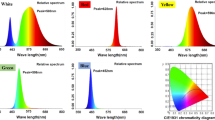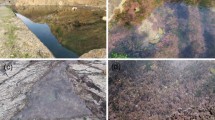Abstract
Photosynthesis and respiration by the epilithic community on cobble in an arctic tundra stream, were estimated from oxygen production and consumption in short-term (4–12 h), light and dark, chamber incubations. Chlorophyll a was estimated at the end of each incubation by quantitatively removing the epilithon from the cobble.
Fertilization of the river with phosphate alone moderately increased epilithic chlorophyll a, photosynthesis, and respiration. Fertilization with ammonium sulfate and phosphate, together, greatly increased each of these variables. Generally, under both control and fertilized conditions, epilithic chlorophyll a concentrations (mg m−2), photosynthesis, and respiration (mg O2 m−2, h−1) were higher in pools than in riffles. Under all conditions, the P/R ratio was consistent at ∼ 1.8 to 2.0. The vigor of epilithic algae in riffles, estimated from assimilation coefficients (mg O2 [mg Chl a]−1 h−1) was greater than the vigor of epilithic algae in pools. However, due to the greater accumulation of epilithic chlorophyll a in pools, total production (and respiration) in pools exceeded that in riffles. The epilithic community removed both ammonium and nitrate from water in chambers. Epilithic material, scoured by high discharge in response to storm events and suspended in the water column, removed ammonium and may have increased nitrate concentrations in bulk river water. However, these changes were small compared to the changes exerted by attached epilithon.
Similar content being viewed by others
References
APHA, 1985. Standard methods for the examination of water and wastewater, 16th edition. Greenberg, A. E., R. R. Trussell & L. S. Clesceri (Eds.). American Public Health Association, Washington.
Bendschneider, K. & R. J. Robinson, 1952. A new spectrophotometric method for the determination on nitrite in sea water. J. mar. Res. 11: 87–96.
Bott, T. L., J. R. Brock, C. E. Cushing, S. V. Gregory, D. King & R. C. Petersen, 1978. A comparison of methods for measuring primary productivity and community respiration in streams. Hydrobiologia 60: 3–12.
Craig, P. C. & P. J. McCart, 1975. Classification of stream types in Beauford Sea drainages between Prudhoe Bay, Alaska and the Mackenzie Delta, N.W.T., Canada. Arctic and Alpine Res. 7: 183–198.
Duff, J. H., K. C. Stanley & R. J. Avanzino, 1984. The use of photosynthesis-respiration chambers to measure nitrogen flux in epilithic algal communities. Verh. int. Ver. Limnol. 22:1436–1443.
Elliot, R. J. & A. G. Porter, 1971. A rapid cadmium reduction method for the determination of nitrate in bacon and curing brines. Analyst 96: 522–527.
Grasshoff, K. & J. Johannsen, 1972. A new sensitive and direct method for the automatic determination of ammonia in seawater. J. Cons. int. Explor. Mer. 34: 516–521.
Groeger, A. W. & B. L. Kimmel, 1989. Relationship between photosynthetic and respiratory carbon metabolism in freshwater phytoplankton. Hydrobiologia 173: 107–117.
Jones, M. N., 1984. Nitrate reduction by shaking with cadmium. Wat. Res. 18: 643–646.
King, D. K., 1982. Community metabolism and autotrophicheterotrophic relationships of woodland stream riffle sections. Ph.D. Thesis. Michigan State University, East Lansing. 356 pp.
King, D. K. & K. W. Cummins, 1989a. Autotrophic-heterotrophic community metabolism relationships of a woodland stream. J. Freshwat. Ecol. 5: 205–218.
King, D. K. & K. W. Cummins, 1989b. Factors affecting autotrophic-heterotrophic relationships of a woodland stream.J. Freshwat. Ecol. 5: 219–230.
Lock, M. A., T. E. Ford, D. M. Fiebig, M. C. Miller, M. Hullar, J. R. Vestal, B. J. Peterson & J. E. Hobbie, 1989. A biogeochemical survey of rivers and streams in the mountains and foot-hills province of arctic Alaska. Arch. Hydrobiol. 115: 499–521.
Lock, M. A., R. R. Wallace, J. W. Costerton, R. M. Ventullo & S. E. Charlton, 1984. River epilithon: toward a structuralfunctional model. Oikos 42: 10–22.
MacKereth, F. J. H., J. Heron & T. F. Talberg, 1978. Nitrate. In: MacKereth, F. J. H., J. Heron & T. F. Talberg (Eds.), Water analysis: some revised methods for limnologists, Freshwater Biological Association, Windermere, U.K.: 72–73.
Minshall, G. W., 1978. Autotrophy in stream ecosystems. BioScience 28: 767–771.
Murphy, M. L., 1984. Primary production and grazing in freshwater and intertidal reaches of a coastal stream, southeast Alaska. Limnol. Oceanogr. 29: 805–815.
Naiman, R. J., 1983. The annual pattern and spatial distribution of aquatic oxygen metabolism in boreal forest watersheds. Ecol. Monogr. 53: 73–94.
Naiman, R. J. & J. R. Sedell, 1980. Relationships between metabolic parameters and stream order in Oregon. Can. J. Fish. aquat. Sci. 37: 834–847.
Odum, H. T., 1956. Primary production in flowing rivers. Limnol. Oceanogr. 1: 102–117.
Pennak, R. W. & J. W. Lavelle, 1979. In situ measurements of net primary production in a Colorado mountain stream. Hydrobiologia 66: 227–235.
Peterson, B. J., J. E. Hobbie & T. L. Corliss, 1983. A continuous flow periphyton bioassay: tests of nutrient limitation in a tundra stream. Limnol. Oceanogr. 28: 583–591.
Peterson, B. J., J. E. Hobbie & T. L. Corliss, 1986. Carbon flow in a tundra stream ecosystem. Can. J. Fish. aquat. Sci. 43: 1259–1270.
Peterson, B. J., J. E. Hobbie, A. E. Hershey, M. A. Lock, T. E. Ford, J. R. Vestal, V. L. McKinley, M. A. H. Hullar, M. C. Miller, R. M. Ventullo & G. S. Volk, 1985. Transformations of a tundra river from heterotrophy to autotrophy by addition of phosphorus. Science 229: 1383–1386.
Vannote, R. L., K. W. Cummins, G. W. Minshall, J. R. Sedell & C. E. Cushing, 1980. The river continuum concept. Can. J. Fish. aquat. Sci. 37: 130–137.
Author information
Authors and Affiliations
Rights and permissions
About this article
Cite this article
Bowden, W.B., Peterson, B.J., Finlay, J.C. et al. Epilithic chlorophyll a, photosynthesis, and respiration in control and fertilized reaches of a tundra stream. Hydrobiologia 240, 121–131 (1992). https://doi.org/10.1007/BF00013457
Issue Date:
DOI: https://doi.org/10.1007/BF00013457




